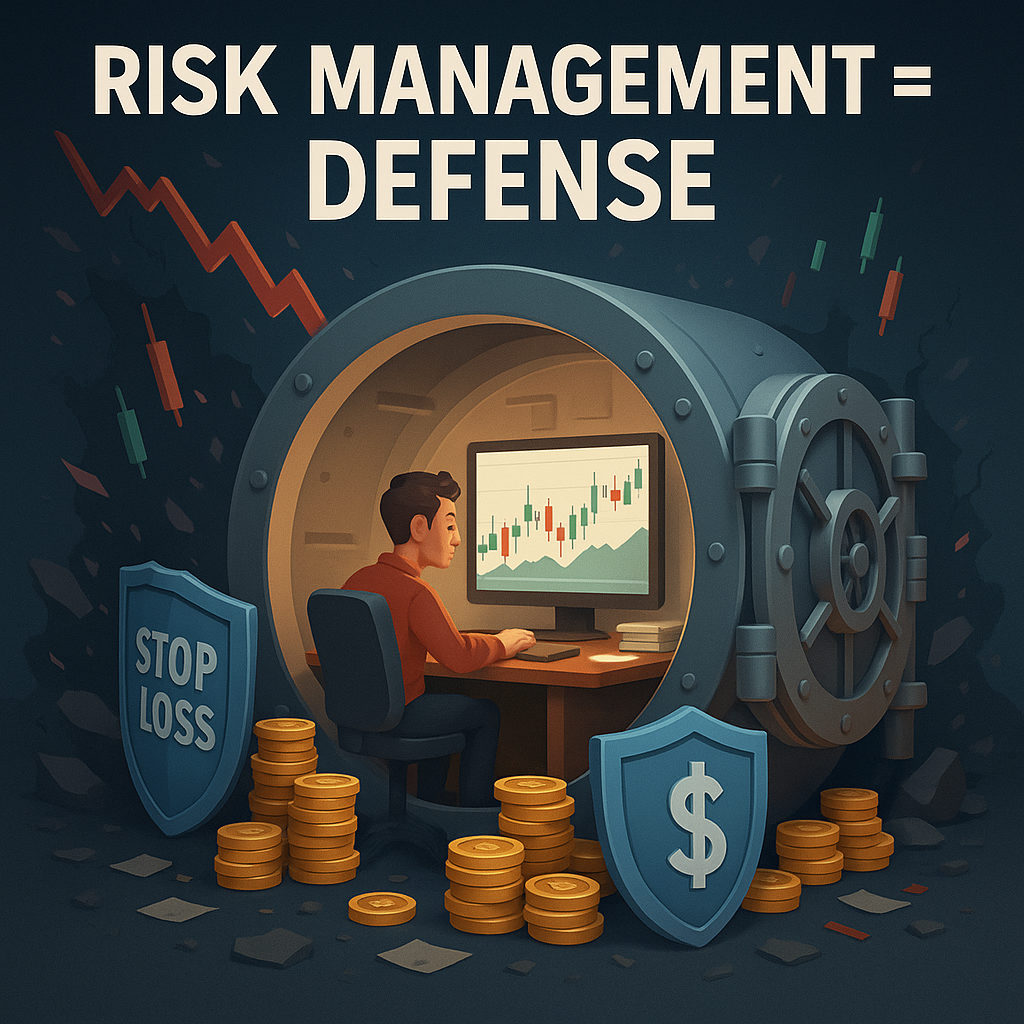Let me tell you something that’ll save you more money than any trading strategy, indicator, or guru course ever will: Risk management is the ONLY thing that matters in trading. Not your win rate. Not your strategy. Not your analysis. Risk management.
I learned this after blowing up three accounts totaling $125,000. Three fucking times I had to explain to my wife why our savings were gone. Three times I had to start over from zero. You know what the difference was between losing everything and now consistently making $15,000-20,000 per month? Risk management.
Every professional trader will tell you the same thing: We don’t make money because we’re good at predicting the market. We make money because we’re good at not losing money. That sounds like bullshit zen master talk, but it’s the absolute truth. The market will humble everyone eventually. The only question is whether you’ll survive to trade another day.
This is the guide I wish someone had beaten into my skull before I lost everything. Multiple times.
The Truth About Trading Nobody Wants to Hear
Before we dive into strategies, let me destroy some illusions:

90% of traders lose money. Not because they can’t find winning trades. Because they can’t manage risk.
The other 10% aren’t smarter. They just learned to protect their capital first and make money second.
You will be wrong 40-50% of the time. Even the best traders. Ray Dalio is wrong 40% of the time. Paul Tudor Jones is wrong 45% of the time. You’re not better than them.
One trade can end your career. I’ve seen traders turn $10K into $500K, then lose it all on one position. One. Fucking. Trade.
The market doesn’t care about your bills. Your mortgage, your kids’ tuition, your car payment – the market gives zero fucks. Trade accordingly.
The Foundation: Position Sizing (The Most Important Section You’ll Ever Read)
Position sizing is 90% of risk management. Get this wrong and nothing else matters.
The 1-2% Rule (The Golden Rule)
Never risk more than 1-2% of your account on a single trade. Ever. No exceptions.
The Math:
- $10,000 account × 2% = $200 max risk per trade
- $50,000 account × 2% = $1,000 max risk per trade
- $100,000 account × 2% = $2,000 max risk per trade
Why This Works:
- You can be wrong 50 times in a row and still have money
- Removes emotion from trading
- Allows for comeback after drawdowns
- Keeps you in the game
Real Example:
Account: $25,000
Risk per trade: 2% = $500
Stop loss: $2 below entry
Position size: $500 ÷ $2 = 250 shares
If stop hits: Lose $500 (2%)
If target hits (3:1): Make $1,500 (6%)
The Position Sizing Formula
Position Size = (Account Risk ÷ Trade Risk)
Where:
- Account Risk = Account Size × Risk Percentage
- Trade Risk = Entry Price - Stop Loss Price
Stock Example:
- Account: $50,000
- Risk: 1% = $500
- Entry: $100
- Stop: $98
- Trade Risk: $2
- Position Size: $500 ÷ $2 = 250 shares
Options Example:
- Account: $50,000
- Risk: 2% = $1,000
- Option Price: $5.00
- Stop: 50% loss ($2.50)
- Trade Risk: $250 per contract
- Position Size: $1,000 ÷ $250 = 4 contracts
The Kelly Criterion (For Math Nerds)
The optimal position size based on your edge:
Kelly % = (Win% × Average Win) - (Loss% × Average Loss) / Average Win
Example:
- Win Rate: 60%
- Average Win: $1,000
- Average Loss: $500
Kelly % = (0.60 × $1,000) – (0.40 × $500) / $1,000 = 40%
Reality Check: Kelly suggests 40% of account. That’s insane. Use 1/4 Kelly maximum (10% in this case).
The Scaling Method (What I Actually Use)
Conviction Levels:
- Low Conviction: 0.5% risk
- Normal Trade: 1% risk
- High Conviction: 1.5% risk
- Maximum Conviction: 2% risk
Never go above 2%. Ever. I don’t care if God himself gives you the trade.
Stop Losses: Your Life Insurance Policy
A stop loss is not admitting defeat. It’s preserving capital for the next opportunity.
Types of Stop Losses
Hard Stop (The Best Kind)
- Set it and forget it
- Can’t be moved
- Removes emotion
- Automatically executes
Mental Stop (The Dangerous Kind)
- “I’ll sell if it hits X”
- Usually moved when tested
- Emotion overrides logic
- Account killer
Trailing Stop (The Smart Kind)
- Moves up with winning position
- Locks in profits
- Never moves down
- Best of both worlds
Time Stop (The Underrated Kind)
- Exit after X days if flat
- Prevents dead money
- Opportunity cost management
- Forces decisiveness
Where to Place Stops
Technical Stops (Most Common)
- Below support levels
- Beyond recent lows
- Outside of normal volatility
- At logical invalidation points
Real Example:
Stock bouncing off $50 support
Entry: $51
Stop: $49.50 (below support)
Risk: $1.50 per share
ATR Stops (The Professional Method)
- Use Average True Range
- Stop = Entry – (2 × ATR)
- Accounts for volatility
- Mathematically sound
Example:
Entry: $100
14-day ATR: $2
Stop: $100 - (2 × $2) = $96
Gives room for normal movement
Percentage Stops (The Simple Method)
- Fixed percentage from entry
- Usually 5-7% for stocks
- 20-30% for options
- Easy to calculate
Dollar Stops (The Practical Method)
- Based on account risk
- “I can lose $500 on this trade”
- Work backwards to position size
- Keeps risk consistent
The Stop Loss Rules That Save Lives
Rule 1: Set It Before You Enter
- Know your exit before entry
- Write it down
- Make it official
- No exceptions
Rule 2: Never Move It Against You
- Can move up (trail)
- Never move down
- “Just a little more room” = death
- Discipline > hope
Rule 3: Honor It Immediately
- Stop hit = exit now
- No “let’s see what happens”
- No “it might bounce”
- Mechanical execution
Rule 4: Size Position for the Stop
- Stop determines position size
- Not the other way around
- Wide stop = smaller position
- Tight stop = larger position
Risk/Reward Ratios (The Math of Profitable Trading)
You can be wrong more than right and still make money. It’s all about risk/reward.
The Minimum Acceptable Ratios
1:1 Risk/Reward = Gambling
- Need 50%+ win rate to profit
- No edge after costs
- Why bother?
1:2 Risk/Reward = Minimum
- 33% win rate = breakeven
- 40% win rate = profitable
- My minimum for any trade
1:3 Risk/Reward = Ideal
- 25% win rate = breakeven
- 35% win rate = very profitable
- My target ratio
1:5+ Risk/Reward = Home Runs
- Rare but powerful
- 20% win rate = profitable
- Focus on these setups
The Risk/Reward Math
Scenario 1: Poor Risk/Reward
10 trades
Risk: $100, Reward: $100 (1:1)
6 wins × $100 = $600
4 losses × $100 = -$400
Net: $200 (20% return on risk)
Scenario 2: Good Risk/Reward
10 trades
Risk: $100, Reward: $300 (1:3)
4 wins × $300 = $1,200
6 losses × $100 = -$600
Net: $600 (60% return on risk)
Notice: Lower win rate, higher profit. This is the secret.
How to Calculate Risk/Reward
Risk/Reward = (Target - Entry) ÷ (Entry - Stop)
Example:
- Entry: $50
- Stop: $48
- Target: $56
- Risk: $2
- Reward: $6
- Ratio: $6 ÷ $2 = 3:1
If ratio is less than 2:1, don’t take the trade.
The Maximum Loss Rules (Protecting Against Catastrophe)
Daily Loss Limits
The 3% Rule
- Down 3% for the day = stop trading
- No exceptions
- Computer off
- Walk away
Why This Works:
- Prevents revenge trading
- Stops emotional spirals
- Preserves capital
- Forces reset
My Actual Limits:
- Down 2% = Last trade allowed
- Down 3% = Done for day
- Down 5% = Done for week
Weekly Loss Limits
The 6% Rule
- Down 6% for the week = stop
- Review what went wrong
- Paper trade until confident
- Don’t force trades
The Psychology:
- Bad weeks happen
- Don’t make them disasters
- Live to trade next week
- Comeback is possible from -6%, not -20%
Monthly Loss Limits
The 10% Rule
- Down 10% for month = major review
- Something is broken
- Strategy, mindset, or market conditions
- May need total reset
What to Do:
- Stop trading immediately
- Review every trade
- Identify the problem
- Paper trade solutions
- Return with smaller size
The Consecutive Loss Rule
Three Strikes You’re Out
- 3 losses in a row = stop for day
- 5 losses in a row = stop for week
- 7 losses in a row = strategy is broken
Why This Matters:
- Losing streaks affect psychology
- Confidence erodes
- Decisions get worse
- Need to break the cycle
Diversification and Correlation (Don’t Put All Eggs in One Basket)
Position Correlation
The Hidden Risk
- Long AAPL, MSFT, GOOGL
- Think you have 3 positions
- Really have 1 big tech position
- All move together
The Rule:
- Maximum 3 correlated positions
- Check correlation coefficient
- Above 0.7 = highly correlated
- Treat as one position
Example of Hidden Correlation:
Long:
- SPY calls
- QQQ calls
- AAPL calls
- NVDA calls
Market drops 2% = All four lose
Really just one big long position
Sector Diversification
Maximum Sector Exposure:
- No more than 30% in one sector
- Spread across industries
- Don’t chase hot sectors
- Boring diversification saves accounts
My Allocation:
- Tech: 25% maximum
- Finance: 20% maximum
- Healthcare: 20% maximum
- Energy: 15% maximum
- Other: 20% minimum
Strategy Diversification
Don’t Rely on One Strategy
- Day trading: 30% of activity
- Swing trading: 40% of activity
- Options premium: 30% of activity
Why Multiple Strategies:
- Markets change
- Strategies stop working
- Income diversification
- Reduced drawdowns
Time Diversification
Don’t Enter Everything at Once
- Scale into positions
- Different expiration dates
- Staggered entries
- Dollar-cost averaging for investments
The Psychology of Risk Management
Why Traders Ignore Risk Management
The Greed Factor
- “This trade is different”
- “I know it’ll work”
- “Just this once”
- Famous last words
The Ego Problem
- Can’t admit being wrong
- Stop loss = admitting defeat
- Pride costs more than stops
- Market humbles everyone
The Desperation Trade
- Need to make rent
- Must recover losses
- Bills are due
- Worst possible mindset
The FOMO Disease
- Everyone else making money
- Must catch up
- Take bigger risks
- Blow up faster
The Professional Mindset
Think in Probabilities
- No trade is guaranteed
- Plan for being wrong
- Hope for being right
- Execute regardless
Treat It Like a Business
- McDonald’s has food costs
- Trading has loss costs
- Part of doing business
- Price of admission
Focus on Process
- Perfect execution matters
- Results are secondary
- Process creates profits
- Trust the system
Advanced Risk Management Techniques
The Options Greeks Risk
Delta Risk
- Total portfolio delta
- Market exposure
- Keep balanced or directional
- Know your number
Gamma Risk
- Acceleration of delta
- Explosion risk near expiration
- Keep under control
- Especially for short options
Theta Risk
- Time decay exposure
- Friend or enemy?
- Positive theta = income
- Negative theta = cost
Vega Risk
- Volatility exposure
- Can kill during events
- Monitor VIX
- Hedge when necessary
Portfolio Heat
What is Portfolio Heat? Total capital at risk across all positions
Calculation:
Sum of all position risks ÷ Account size
Example:
- Position 1: $500 risk
- Position 2: $300 risk
- Position 3: $400 risk
- Total Risk: $1,200
- Account: $20,000
- Portfolio Heat: 6%
Maximum Heat: 6-10%
- Never exceed 10%
- Preferably under 6%
- During uncertainty: 3-4%
- Protects against correlation
The Volatility Adjustment
High Volatility Markets
- Reduce position size 50%
- Wider stops needed
- More false signals
- Preservation mode
Low Volatility Markets
- Can increase size slightly
- Tighter stops work
- Better signal quality
- Opportunity mode
Measuring Volatility:
- VIX above 20 = High volatility
- VIX below 15 = Low volatility
- ATR expanding = Increasing volatility
- Adjust accordingly
Risk Management Tools and Software
Essential Tools (Free)
Spreadsheet (Excel/Google Sheets)
- Track every trade
- Calculate position sizes
- Monitor portfolio heat
- Review performance
My Tracking Columns:
Date | Symbol | Entry | Stop | Target | Shares | Risk$ | Risk% | Result | Notes
Position Size Calculator
- Available free online
- Input: Account, Risk%, Stop
- Output: Position size
- Use every trade
Professional Tools ($50-200/month)
Risk Management Software
- Edgewonk (journaling)
- TraderSync (analytics)
- TradingView (risk calculator)
- Riskalyze (portfolio risk)
Real-Time Monitoring
- Track portfolio heat
- Correlation analysis
- VAR calculations
- Stress testing
Broker Risk Tools
Most Brokers Offer:
- Risk analysis
- Portfolio margin
- Stress test tools
- Correlation matrix
Use Them All
- Free with account
- Often overlooked
- Valuable insights
- Prevent disasters
My Personal Risk Management System
After 8 years and multiple blow-ups, here’s exactly what I do:
Pre-Market Routine
- Check Account Balance
- Know exact number
- Calculate 2% risk
- Set daily loss limit
- Write it down
- Review Open Positions
- Current risk exposure
- Portfolio heat
- Correlation check
- Adjust if needed
- Plan New Trades
- Risk/reward calculation
- Position size calculation
- Stop loss levels
- Maximum 3 new positions
During Market Hours
Entry Checklist:
- [ ] Risk/Reward minimum 1:2?
- [ ] Position size calculated?
- [ ] Stop loss set?
- [ ] Portfolio heat under 10%?
- [ ] Correlated positions checked?
- [ ] Mental state clear?
If any answer is no, don’t trade.
Post-Market Review
- Calculate Daily P&L
- Review Trades Taken
- Update Position Sizes
- Check Tomorrow’s Risk
- Journal Lessons Learned
The Results
Before Risk Management:
- 3 blown accounts
- -$125,000 total
- Constant stress
- Nearly divorced
After Risk Management:
- 3 years profitable
- +$420,000 total
- Sleep at night
- Still married
Common Risk Management Mistakes
Mistake 1: “This Time Is Different”
The Sin: Breaking rules for “sure things” The Result: Largest losses come from “sure things” The Fix: Rules apply to every trade, no exceptions
Mistake 2: Averaging Down
The Sin: Adding to losing positions The Result: Small loss becomes catastrophic The Fix: Never add to losers, only winners
Mistake 3: Moving Stop Losses
The Sin: Giving trades “more room” The Result: Small losses become large losses The Fix: Stop = stop, period
Mistake 4: Oversizing Winners
The Sin: “I’m on a hot streak” The Result: One loss wipes out five wins The Fix: Consistent position sizing always
Mistake 5: Ignoring Correlation
The Sin: 10 positions, all tech stocks The Result: Sector rotation = account destruction The Fix: True diversification
Mistake 6: Trading to Make Back Losses
The Sin: Revenge trading The Result: Deeper hole The Fix: Each trade independent
The Risk Management Commandments
After everything I’ve learned, these are non-negotiable:
- Never Risk More Than 2% Per Trade
- Always Set Stop Loss Before Entry
- Never Move Stop Loss Against You
- Maintain Portfolio Heat Under 10%
- Honor Daily Loss Limits
- Calculate Position Size Every Trade
- Require Minimum 2:1 Risk/Reward
- Check Correlation Before Entry
- Scale Into Positions
- Journal Every Trade
Break any of these and you’re gambling, not trading.
The 30-Day Risk Management Challenge
Want to transform your trading? Do this for 30 days:
Week 1: Foundation
- Risk only 1% per trade
- Set stops before entry
- Track every trade
- Calculate position sizes
Week 2: Discipline
- Add daily loss limits
- Never move stops down
- Exit at stops immediately
- Review each day
Week 3: Advanced
- Check correlations
- Monitor portfolio heat
- Add risk/reward filter
- Scale positions
Week 4: Mastery
- Combine all elements
- Perfect execution
- Review and adjust
- Build habits
Success Metrics:
- Not profit (that comes later)
- Perfect rule following
- No blown stops
- Consistent sizing
The Bottom Line Truth
Risk management isn’t sexy. It won’t make you rich overnight. You won’t screenshot your risk management for Instagram. But it’s the difference between trading for 20 years and blowing up in 20 days.
Every professional trader I know has blown up at least one account. The difference between us and the 90% who fail? We learned that risk management is everything. Strategy is maybe 10% of success. Psychology is 30%. Risk management is 60%.
You can have the best strategy in the world, but without risk management, you’re just gambling with extra steps. You can have mediocre strategy with great risk management and make consistent money for decades.
The Choice Is Simple:
- Ignore risk management and join the 90% who fail
- Master risk management and join the 10% who survive
The Market’s Truth: The market will take everything you have if you let it. Your job isn’t to beat the market. Your job is to not let the market beat you. Risk management is how you do that.
My Final Advice: Print out the Risk Management Commandments. Put them next to your computer. Read them before every trading session. Follow them religiously. In a year, you’ll either thank me or ignore this advice and blame the market for your losses.
The market doesn’t care about your opinion. It doesn’t care about your analysis. It doesn’t care about your bills. But if you respect it with proper risk management, it might just let you take some money home.
Remember: In trading, offense wins games, but defense wins championships. Risk management is your defense. Master it, or the market will master you.







